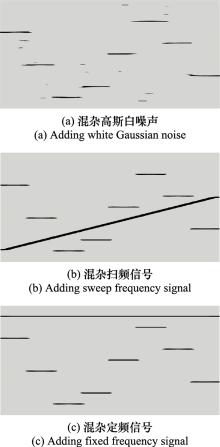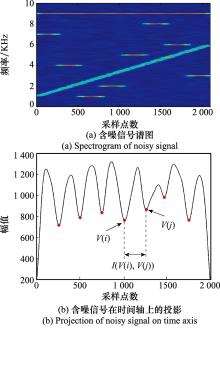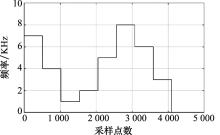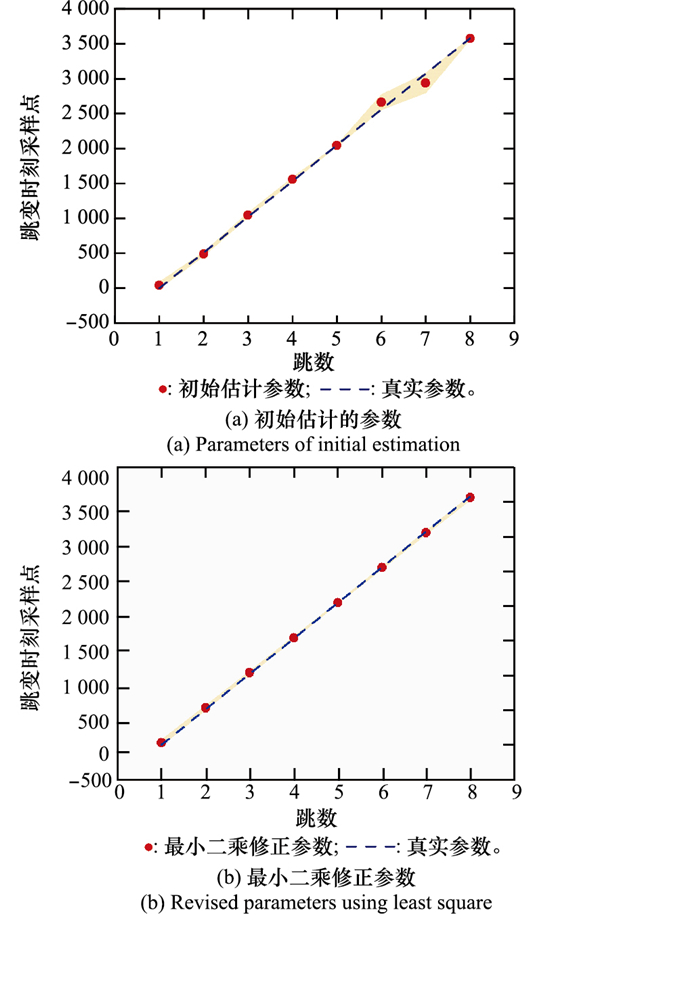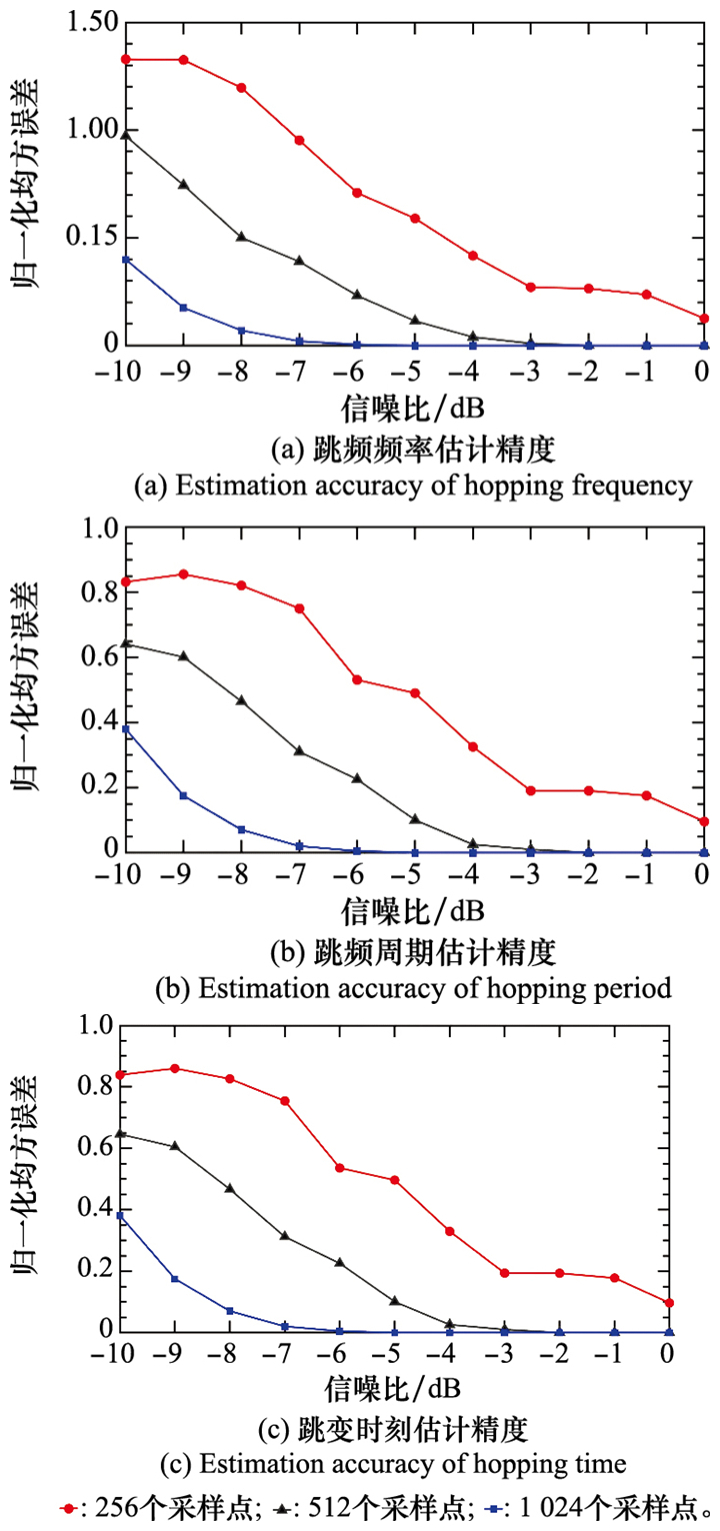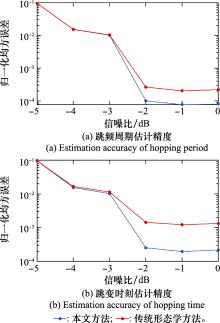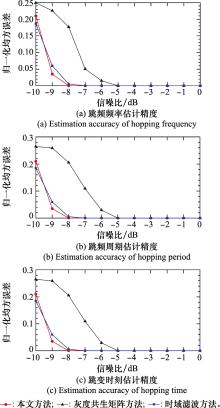Systems Engineering and Electronics ›› 2021, Vol. 43 ›› Issue (5): 1398-1405.doi: 10.12305/j.issn.1001-506X.2021.05.29
• Communications and Networks • Previous Articles Next Articles
Joint blind parameter estimation of frequency hopping signal based on adaptive morphology
Manying WANG( ), Xiaofeng GONG*(
), Xiaofeng GONG*( ), Ruisen LUO(
), Ruisen LUO( ), Tong BIAN(
), Tong BIAN( ), Zhiyuan WANG(
), Zhiyuan WANG( )
)
- College of Electrical Engineering, Sichuan University, Chengdu 610065, China
-
Received:2020-07-09Online:2021-05-01Published:2021-04-27 -
Contact:Xiaofeng GONG E-mail:manying_w@foxmail.com;50906650@qq.com;rui510104@163.com;1460424927@qq.com;1271105758@qq.com
CLC Number:
Cite this article
Manying WANG, Xiaofeng GONG, Ruisen LUO, Tong BIAN, Zhiyuan WANG. Joint blind parameter estimation of frequency hopping signal based on adaptive morphology[J]. Systems Engineering and Electronics, 2021, 43(5): 1398-1405.
share this article
| 1 | KIM N K, OH S J. Comparison of methods for parameter estimation of frequency hopping signals[C]//Proc. of the IEEE International Conference on Information and Communication Technology Convergence: ICT Convergence Technologies Leading the 4th Industrial Revolution, 2017: 567-569. |
| 2 | 张盛魁, 姚志成, 何岷, 等. 改进时频脊线的跳频参数盲估计算法[J]. 系统工程与电子技术, 2019, 41 (12): 2885- 2890. |
| ZHANG S K , YAO Z C , HE M , et al. Blind estimation algorithm for frequency hopping parameters of improved time-frequency ridge[J]. Systems Engineering and Electronics, 2019, 41 (12): 2885- 2890. | |
| 3 |
ZHANG M , XU S C , GUO A F . Parameter estimation of multi frequency hopping signals based on space-time-frequency distribution[J]. Symmetry, 2019, 11 (5): 648- 665.
doi: 10.3390/sym11050648 |
| 4 | JANANI M, VAKILI V T, JAMALI H. The modified autocorrelation technique for parameter estimation of random FH signals[C]//Proc. of the IEEE 4th International Conference on Signal Processing, 1998: 188-190. |
| 5 | AZIZ J S, AL-SHALCHI A A, AL-KATEEB A K, et al. Parameter estimation of frequency-hopping (FH-SS) signals using modified autocorrelation techniques[C]// Proc. of the IEEE International Conference on Communication Technology Proceedings, 2006: 901-904. |
| 6 | 钱博, 冯永新, 潘成胜, 等. 一种基于多跳自相关的差分跳频信号检测方法[J]. 航空学报, 2011, 32 (12): 2268- 2276. |
| QIAN B , FENG Y X , PAN C S , et al. A method of detecting differential frequency hopping signal based on multiple-hop autocorrelation[J]. Acta Aeronautica et Astronautica Sinica, 2011, 32 (12): 2268- 2276. | |
| 7 | ZHANG Y S, JIA X, YIN C B. Time-frequency analysis of frequency hopping signal based on partial reconstruction[C]//Proc. of the IEEE International Conference on Signal Processing, Communications and Computing, 2017. |
| 8 |
FU W H , JIANG T . A parameter estimation algorithm for multiple frequency-hopping signals based on compressed sensing[J]. Physical Communication, 2019, 37, 100892.
doi: 10.1016/j.phycom.2019.100892 |
| 9 | 张朝柱, 王宇, 荆福龙. 利用稀疏贝叶斯理论的跳时估计方法[J]. 西安电子科技大学学报, 2019, 46 (3): 39- 44. |
| ZHANG C Z , WANG Y , JING F L . Hop timing estimation method by exploiting sparse Bayesian inference[J]. Journal of Xidian University, 2019, 46 (3): 39- 44. | |
| 10 |
AYDIN L , POLYDOROS A . Hop-timing estimation for FH signals using a coarsely channelized receiver[J]. IEEE Trans.on Communications, 1996, 44 (4): 516- 526.
doi: 10.1109/26.489098 |
| 11 | AYDM L, POLYDOROS A. Joint hop-timing estimation for FH signals using a coarsely channelized receiver[C]//Proc. of the IEEE Military Communications Conference, 2002: 775-779. |
| 12 | ZHAO Z, YAO Y, SHANG J N. Frequency hopping signals analysis based on image processing[C]//Proc. of the IEEE International Conference on Neural Networks and Signal Processing, 2008: 560-564. |
| 13 | GU P , WANG B . A blind extraction method of FH signals based on improved symmetric co-occurrence matrix in HF channel[J]. Applied Mechanics & Materials, 2014, 543 |
| 14 | 席有猷, 李志刚, 王苗. 结合图像处理与时频分析的直扩/跳频信号参数估计[J]. 电讯技术, 2014, 54 (8): 1071- 1076. |
| XI Y Y , LI Z G , WANG M . Parameters estimation of DS/FH signal based on image processing and time-frequency analysis[J]. Telecommunication Engineering, 2014, 54 (8): 1071- 1076. | |
| 15 |
吕晨杰, 王斌, 王开勋. 采用图像处理的跳频信号参数盲估计[J]. 电讯技术, 2015, 55 (8): 842- 847.
doi: 10.3969/j.issn.1001-893x.2015.08.003 |
|
LYU C J , WANG B , WANG K X . Blind parameter estimation of frequency hopping signals by image processing[J]. Telecommunication Engineering, 2015, 55 (8): 842- 847.
doi: 10.3969/j.issn.1001-893x.2015.08.003 |
|
| 16 | ZHANG Q, LIU Y H, ZHANG X X. Parameter estimation of non-modulated or modulated frequency-hopping signals[C]// Proc. of the IEEE International Conference on Signal Processing, Communications and Computing, 2016. |
| 17 | NGUYEN H Q, NGUYEN H P K, NGUYEN B T. An image processing approach to wideband spectrum sensing of heterogeneous signals[C]//Proc. of the Lecture Notes of the Institute for Computer Sciences, Social-Informatics and Telecommunications Engineering, 2019: 211-221. |
| 18 | 王欣怡, 南心蒙, 李柯达, 等. OPTA细化算法在跳频信号参数估计中的应用[J]. 弹箭与制导学报, 2019, 39 (6): 116- 119. |
| WANG X Y , NAN X M , LI K D , et al. Application of OPTA algorithm in parameter estimation of frequency-hopping signals[J]. Journal of Projectiles, Rockets, Missiles and Guidance, 2019, 39 (6): 116- 119. | |
| 19 | 张晔. 信号时频分析及应用[M]. 第一版 哈尔滨: 哈尔滨工业大学出版社, 2006. |
| ZHANG Y . Time frequency analysis and application of signal[M]. 1st ed Harbin: Harbin Institute of Technology Press, 2006. | |
| 20 |
MACK W , EMANUЁL A P H . Deep filtering: signal extraction and reconstruction using complex time-frequency filters[J]. IEEE Signal Processing Letters, 2020, 27, 61- 65.
doi: 10.1109/LSP.2019.2955818 |
| 21 | KAPLAN B, KAHRAMAN I, GORCIN A, et al. Measurement based FHSS-type drone controller detection at 2.4 GHz: an STFT approach[C]//Proc. of the IEEE 91st Vehicular Technology Conference, 2020. |
| 22 | ALKALI A H, SAATCHI R, ELPHICK H, et al. Short-time Fourier and wavelet transform analysis of respiration signal obtained by thermal imaging[C]//Proc. of the IEEE 9th International Symposium on Communication Systems, Networks & Digital Sign, 2014: 183-187. |
| 23 | GONZALEZ R C G , WOODS R E . Digital image processing[M]. 2nd ed Beijing: Publishing House of Electronics Industry, 2002: 420- 427. |
| 24 | LI S , LI L G . An optimization method for image edge detection based on fractal theory and mathematical morphology[J]. Boletin Tecnico/Technical Bulletin, 2017, 55 (16): 673- 680. |
| 25 |
LIU L Y , JIA Z H , YANG J , et al. SAR image change detection based on mathematical morphology and the K-means clustering algorithm[J]. IEEE Access, 2019, 7, 43970- 43978.
doi: 10.1109/ACCESS.2019.2908282 |
| 26 | 沈凤麟, 叶中付, 钱玉美. 信号统计分析与处理[M]. 合肥: 中国科学技术大学出版社, 2001: 365- 367. |
| SHEN F L , YE Z F , QIAN Y M . Statistical analysis and processing of signals[M]. Hefei: Press of University of Science and Technology of China, 2001: 365- 367. | |
| 27 | ZHOU C, WANG Y K, QIAO C J, et al. Least-squares estimation for linear models with certain ranges[C]//Proc. of the IEEE International Conference on Natural Computation, 2016: 1898-1903. |
| 28 | WANG W B, FAN G C, NIU F, et al. Analysis and comparison of robust least squares estimation based on multi-constellation integrated navigation[C]//Proc. of the IEEE International Conference on Computer & Communications, 2016: 1752-1756. |
| [1] | Yili HU, Yongbo ZHAO, Sheng CHEN, Ben NIU. Decoherence of conformal electromagnetic vector sensor array by double interpolation fitting method [J]. Systems Engineering and Electronics, 2022, 44(8): 2393-2402. |
| [2] | Yuanyi XIONG, Wenchong XIE. Adaptive iterative monopulse estimation method based on space-time constraint [J]. Systems Engineering and Electronics, 2022, 44(8): 2506-2514. |
| [3] | Yan JIN, Dadi ZHAO, Hongbing JI. Parameter estimation of LFM signals based on NAT functions in impulsive noise [J]. Systems Engineering and Electronics, 2022, 44(3): 762-770. |
| [4] | Cheng FANG, Huijuan LI, Wen LU, Yumeng SONG, Lei YANG. Multi-feature enhancement algorithm for high resolution SAR based on morphological auto-blocking [J]. Systems Engineering and Electronics, 2022, 44(2): 470-479. |
| [5] | Yuchao YANG, Ming FANG, Chenfan ZHAO, Yueqi WANG, Gang FANG. Research on long-time coherent integration and parameter estimation algorithm of high-speed maneuvering targets [J]. Systems Engineering and Electronics, 2022, 44(12): 3811-3820. |
| [6] | Zengmao CHEN, Li LU, Zhiguo SUN, Rongchen SUN. Parameter estimation algorithm of convolutional codes with solving cost function based on conjugate gradient [J]. Systems Engineering and Electronics, 2022, 44(10): 3235-3242. |
| [7] | Yiheng ZHOU, Jun YANG, Saiqiang XIA, Mingjiu LYU. Estimation method of micro-motion parameters for rotor targets under flashing [J]. Systems Engineering and Electronics, 2022, 44(1): 54-63. |
| [8] | Rongyan ZHOU, Jianfeng CHEN, Xiaoqiang LI, Weijie TAN. Optimal deployment method of sensors in localization system based on targets with Gaussian distribution [J]. Systems Engineering and Electronics, 2021, 43(7): 1791-1796. |
| [9] | Ling WANG, Hua PAN, Wei ZHAO. Low complexity 2D-DOA estimation algorithm in the presence of mutual coupling [J]. Systems Engineering and Electronics, 2021, 43(7): 1819-1823. |
| [10] | Binbin LI, Hui CHEN, Weijian LIU, Zhaojian ZHANG, Bilei ZHOU. Joint multi-dimensional parameters estimation for large-sized electromagnetic vector sensor array based on sparse reconstruction in limited snapshots [J]. Systems Engineering and Electronics, 2021, 43(4): 868-874. |
| [11] | Jiahua XU, Xiaokuan ZHANG, Shuyu ZHENG, Binfeng ZONG, Shuchang ZHENG. GTD model parameter estimation and target recognition based on improved 3D-ESPRIT algorithm [J]. Systems Engineering and Electronics, 2021, 43(2): 336-342. |
| [12] | Weiting FENG, Qing LIANG, Jing GU. Micro-motion parameters extraction for rotating targets based on FMCW radar [J]. Systems Engineering and Electronics, 2021, 43(12): 3564-3570. |
| [13] | Jia LIU, Kewei YANG, Jiang JIANG, Boyuan XIA. Parameter estimation method of equipment system based on multi-fidelity surrogate model [J]. Systems Engineering and Electronics, 2021, 43(1): 130-137. |
| [14] | Shengkui ZHANG, Zhicheng YAO, Min HE, Zhiliang FAN, Jian YANG. FH signal parameter blind estimation based on time-frequency variance clustering [J]. Systems Engineering and Electronics, 2020, 42(8): 1662-1667. |
| [15] | Shuxian DONG, Yinghui QUAN, Xiada CHEN, Xia GAO, Yachao LI, Mengdao XING. Interference suppression algorithm based on frequency agility combined with mathematical morphology [J]. Systems Engineering and Electronics, 2020, 42(7): 1491-1498. |
| Viewed | ||||||
|
Full text |
|
|||||
|
Abstract |
|
|||||


